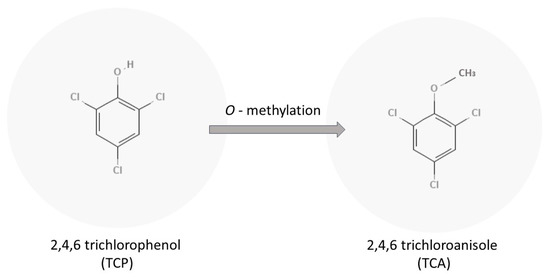Haloanisoles in wine have devastating effects on the aroma and quality of the wine. 2,4,6-trichloroanisole (TCA) was discovered and coined as “cork taint” in 1982. There are many more haloanisoles that contribute to these musty odors, including 2,4,6-Tribromoanisiole (TBA), 2,3,4,6-tetrachloroanisole (TeCA), and pentachloroanisole (PCA). While TCA, TeCA, and PCA can all be traced back to the cork, TBA’s phenol precursor is ubiquitous in building material as a fire retardant, making it a much larger vector. All haloanisoles have the ability to aerosolize and resettle onto surfaces in the winery, making this a very difficult problem to eliminate.
Haloanisoles in wine have devastating effects on the aroma and quality of the wine. 2,4,6-trichloroanisole (TCA) was discovered and coined as “cork taint” in 1982. However, we now understand that there are many more haloanisoles that contribute to these musty odors, including 2,4,6-Tribromoanisiole (TBA), 2,3,4,6-tetrachloroanisole (TeCA), and pentachloroanisole (PCA). While TCA, TeCA, and PCA can all be traced back to the cork, TBA’s phenol precursor is ubiquitous in building material as a fire retardant, making it a much larger vector. All haloanisoles have the ability to aerosolize and resettle onto surfaces in the winery, making this a very difficult problem to eliminate.
- haloanisole
- wine
- pentachloroanisole
- halophenol
- tetrachloroanisole
- trichloroanisole
- tribromoanisole
- cork taint
1. Introduction
2. What Are Haloanisoles in Wine?
Haloanisoles in wine all cause the same musty and moldy odors and are indistinguishable from each other in a wine matrix [3]. Although detrimental to wine quality, haloanisoles are not toxic; however, their halophenol precursors are “highly toxic” [1]. The main difference between the haloanisoles are their sources and how they come into contact with wine.2.1. Trichloroanisole
Trichloroanisole was the first haloanisole identified as the causal compound for musty, moldy aromas in wine in 1982 and is the most well-researched haloanisole in wine. Previously, TCA was only studied as an off flavor in chicken eggs and broilers [1]. TCA was originally found in corks that had been bleached with chlorine bleach in order to create a uniform white color for the corks [1]. The chlorine would mix with the natural fungus present in the cork and produce TCA. The TCA would then be released into the wine once it was sealed and left to age in bottle. Buser proposed that the “replacement of chlorine treatment in the processing of cork” would fix this issue. The industry has since eradicated the use of chlorine bleaching of corks, so how can we still have “corked” wines? Another change that cork producers made after becoming aware of TCA is not washing the corks using public water that contains chlorine for human health and safety [4]. Wineries now also know to dechlorinate the water that they use for wine making if they are using public water. Studies conducted in cork tree forests in Portugal indicated the presence of TCA in the bark. Further research showed a higher concentration of TCA at the base of the trees. The researchers hypothesized that the past use of chlorophenol-based biocides, containing either TCP or PCP, led to these compounds being still present, even though the spraying regime was stopped in the 1980’s [4]. In 2005, a study conducted by Herve found a 76% decrease of ‘releasable TCA’ in corks. He defined releasable TCA as the amount of TCA able to move from the cork into a solution such as wine. It is possible that in the past 17 years since the study conducted by Herve, this amount of releasable TCA has decreased even more. The precursor to TCA is 2,4,6-trichlorophenol or TCP. TCP can be methylated by different fungi to produce TCA as shown in Figure 1. Different fungi showed varying aptitudes to transform the TCP to TCA. Trichoderma and Fusarium were found to be strong methylators with a 25% conversion of TCP to TCA, and Penicillium, A. strictum, C. sitophila, and C. oxysporum were found to be medium methylators, with only a 5–10% transformation of TCP into TCA [1]. A recent study in 2021 found that Aspergillus versicolor and Paecilomyces variotii were found to be strong methylators and are very common in wooden constructions [5].
